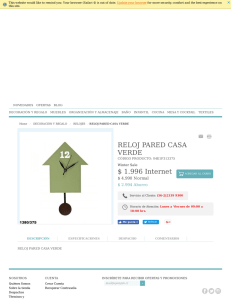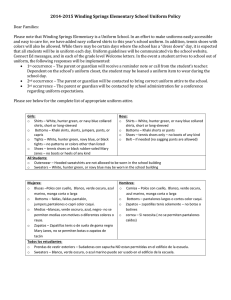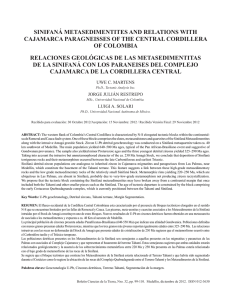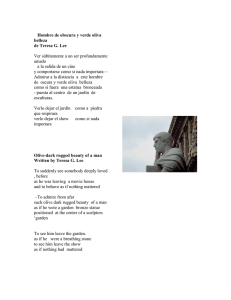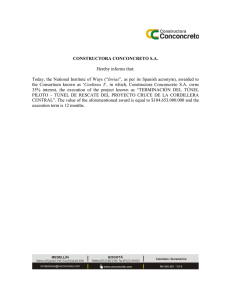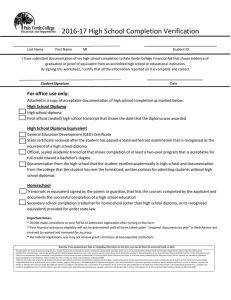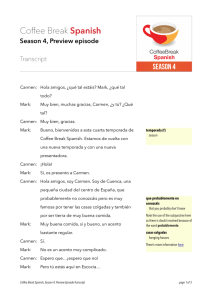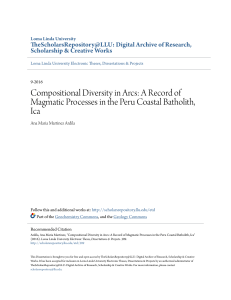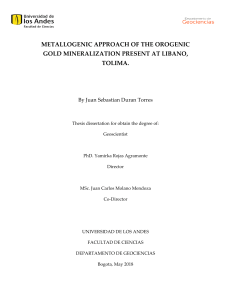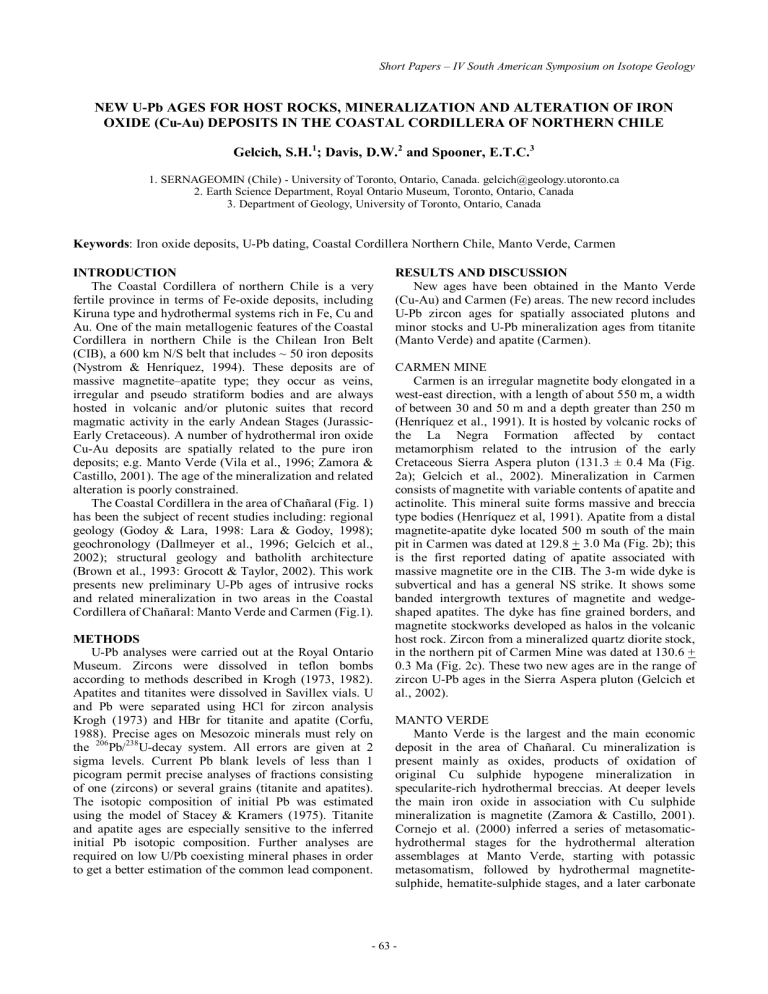
Short Papers – IV South American Symposium on Isotope Geology NEW U-Pb AGES FOR HOST ROCKS, MINERALIZATION AND ALTERATION OF IRON OXIDE (Cu-Au) DEPOSITS IN THE COASTAL CORDILLERA OF NORTHERN CHILE Gelcich, S.H.1; Davis, D.W.2 and Spooner, E.T.C.3 1. SERNAGEOMIN (Chile) - University of Toronto, Ontario, Canada. [email protected] 2. Earth Science Department, Royal Ontario Museum, Toronto, Ontario, Canada 3. Department of Geology, University of Toronto, Ontario, Canada Keywords: Iron oxide deposits, U-Pb dating, Coastal Cordillera Northern Chile, Manto Verde, Carmen INTRODUCTION The Coastal Cordillera of northern Chile is a very fertile province in terms of Fe-oxide deposits, including Kiruna type and hydrothermal systems rich in Fe, Cu and Au. One of the main metallogenic features of the Coastal Cordillera in northern Chile is the Chilean Iron Belt (CIB), a 600 km N/S belt that includes ~ 50 iron deposits (Nystrom & Henríquez, 1994). These deposits are of massive magnetite–apatite type; they occur as veins, irregular and pseudo stratiform bodies and are always hosted in volcanic and/or plutonic suites that record magmatic activity in the early Andean Stages (JurassicEarly Cretaceous). A number of hydrothermal iron oxide Cu-Au deposits are spatially related to the pure iron deposits; e.g. Manto Verde (Vila et al., 1996; Zamora & Castillo, 2001). The age of the mineralization and related alteration is poorly constrained. The Coastal Cordillera in the area of Chañaral (Fig. 1) has been the subject of recent studies including: regional geology (Godoy & Lara, 1998: Lara & Godoy, 1998); geochronology (Dallmeyer et al., 1996; Gelcich et al., 2002); structural geology and batholith architecture (Brown et al., 1993: Grocott & Taylor, 2002). This work presents new preliminary U-Pb ages of intrusive rocks and related mineralization in two areas in the Coastal Cordillera of Chañaral: Manto Verde and Carmen (Fig.1). METHODS U-Pb analyses were carried out at the Royal Ontario Museum. Zircons were dissolved in teflon bombs according to methods described in Krogh (1973, 1982). Apatites and titanites were dissolved in Savillex vials. U and Pb were separated using HCl for zircon analysis Krogh (1973) and HBr for titanite and apatite (Corfu, 1988). Precise ages on Mesozoic minerals must rely on the 206Pb/238U-decay system. All errors are given at 2 sigma levels. Current Pb blank levels of less than 1 picogram permit precise analyses of fractions consisting of one (zircons) or several grains (titanite and apatites). The isotopic composition of initial Pb was estimated using the model of Stacey & Kramers (1975). Titanite and apatite ages are especially sensitive to the inferred initial Pb isotopic composition. Further analyses are required on low U/Pb coexisting mineral phases in order to get a better estimation of the common lead component. RESULTS AND DISCUSSION New ages have been obtained in the Manto Verde (Cu-Au) and Carmen (Fe) areas. The new record includes U-Pb zircon ages for spatially associated plutons and minor stocks and U-Pb mineralization ages from titanite (Manto Verde) and apatite (Carmen). CARMEN MINE Carmen is an irregular magnetite body elongated in a west-east direction, with a length of about 550 m, a width of between 30 and 50 m and a depth greater than 250 m (Henríquez et al., 1991). It is hosted by volcanic rocks of the La Negra Formation affected by contact metamorphism related to the intrusion of the early Cretaceous Sierra Aspera pluton (131.3 ± 0.4 Ma (Fig. 2a); Gelcich et al., 2002). Mineralization in Carmen consists of magnetite with variable contents of apatite and actinolite. This mineral suite forms massive and breccia type bodies (Henríquez et al, 1991). Apatite from a distal magnetite-apatite dyke located 500 m south of the main pit in Carmen was dated at 129.8 + 3.0 Ma (Fig. 2b); this is the first reported dating of apatite associated with massive magnetite ore in the CIB. The 3-m wide dyke is subvertical and has a general NS strike. It shows some banded intergrowth textures of magnetite and wedgeshaped apatites. The dyke has fine grained borders, and magnetite stockworks developed as halos in the volcanic host rock. Zircon from a mineralized quartz diorite stock, in the northern pit of Carmen Mine was dated at 130.6 + 0.3 Ma (Fig. 2c). These two new ages are in the range of zircon U-Pb ages in the Sierra Aspera pluton (Gelcich et al., 2002). MANTO VERDE Manto Verde is the largest and the main economic deposit in the area of Chañaral. Cu mineralization is present mainly as oxides, products of oxidation of original Cu sulphide hypogene mineralization in specularite-rich hydrothermal breccias. At deeper levels the main iron oxide in association with Cu sulphide mineralization is magnetite (Zamora & Castillo, 2001). Cornejo et al. (2000) inferred a series of metasomatichydrothermal stages for the hydrothermal alteration assemblages at Manto Verde, starting with potassic metasomatism, followed by hydrothermal magnetitesulphide, hematite-sulphide stages, and a later carbonate - 63 - Short Papers – IV South American Symposium on Isotope Geology phase. The host rock in Manto Verde is mainly composed of andesitic lavas of the La Negra Formation that are intruded by a number of small dykes. These rocks define a structural block limited by the central and eastern branches of the Atacama Fault System. The Manto Verde structural Block is bounded on the west by the Las Tazas North Pluton (134.1 + 0.4 Ma; Gelcich et al., 2002) and on the east by the Sierra Dieciocho Pluton (129.6 + 0.3 Ma, Fig. 2d; Gelcich et al., 2002). A primary zircon U-Pb crystallization age of 128.9 + 0.6 Ma (Fig. 2e) was obtained for a quartz monzodioritic to granodioritic dyke (felsic intrusive or “pseudo aplite” in the terminology of Zamora & Castillo, 2001). Figure 1. Geological map of the Coastal Cordillera of Chañaral, with the location of Manto Verde and Carmen. The main plutons are labeled. From Godoy & Lara, 1998; Lara & Godoy, 1998. - 64 - Short Papers – IV South American Symposium on Isotope Geology Figure 2. U-Pb concordia diagrams. Carmen ages: A) zircon age of the Sierra Aspera pluton (Gelcich et al., 2002); B) apatite age from magnetite-apatite south dyke; c) quartz dioritic host rock in Carmen north pit. Manto Verde ages. D) zircon age of Sierra Dieciocho Pluton (Gelcich et al., 2002); E) zircon age of the “Felsic Intrusive”; F) titanites associated with potassic alteration of the “Felsic intrusive”. Apatite and titanite ages should be considered preliminary, see text for discussion. This unit shows pervasive potassic alteration (Stage I in the Cornejo et al., 2000, model), including titanite as a major phase. According to Cornejo et al. (2000) titanite represents the alteration product of primary ulvöspinel, with a consequent liberation of Fe to the hydrothermal fluids, which finally precipitated as iron oxides accompanying the main sulphide mineralization. Titanites were dated giving a concordant age of 126.4 + 0.5 Ma (Fig. 2f). U-Pb data from this area define a closely spaced succession of thermal events. They indicate that mineralization in Manto Verde is most probably related to the cooling and differentiation of the Sierra Dieciocho pluton. Both massive magnetite-apatite (Carmen) and Hydrothermal Fe-Cu-Au (Manto Verde) deposits show clear temporal relationships to stocks or dykes that intruded volcanic cover sequences. These later intrusive units represent more differentiated phases that can be temporally and compositional related to the main plutonic units in the area. Thus, Fe oxide mineralization in the coastal Cordillera can be genetically related to the extensive Jurassic to Early Cretaceous plutonism of the Coastal cordillera. ACKNOWLEDGEMENTS We acknowledge Richard Zamora and Boris Castillo for access to samples from Manto Verde, and Sernageomin for their field logistics. Special thanks to Mr. Bob McRae for his essential financial support. REFERENCES Brown, M.; Diaz, F.; Grocott, J. 1993. Displacement history of the Atacama fault system, 26°00’S-27°00’S, northern Chile. Geological Society America Bulletin, 105, p. 1165-1174. Corfu, F. 1988. Differential response of U-Pb systems in coexisting accessory minerals, Winnipeg River Subprovince, Canadian Shield; implications for Archean crustal growth and stabilization. Contributions to Mineralogy and Petrology, vol.98, no.3, p.312-325. - 65 - Short Papers – IV South American Symposium on Isotope Geology Cornejo, P.; Matthews, S.; Orrego, M.; Robles, W. 2000. Etapas de minerlizacion asociadas a alteracion potasica en un sistema de Fe-Cu-Au: Yacimiento Manto Verde, III Region de Atacama, Chile. In: IX Congreso Geologico Chileno, Actas Vol.2 p. 97-101. Dallmeyer, R.D.; Brown, M.; Grocott, J.; Graeme, K.T.; Treolar, P. 1996. Mesozoic magmatic and tectonic events within the Andean plate boundary zone, 26°-27°30’S, north Chile: constraints from 40Ar/39Ar mineral ages. The Journal of Geology, 104, p. 19-40. Gelcich, S.; Davis, D.; Spooner, E.T.C. 2002. U-Pb dating with sub-million year precision of early Andean plutonic rocks in the coastal cordillera of Chañaral, Northern Chile. In V International Symposium on Andean Geodynamics, Toulouse, p. 239-242. Godoy, E. & Lara, L. 1998. Hojas Chañaral y Diego de Almagro, region de Atacama. Servicio Nacional de Geologia y Mineria. Mapas Geologicos No 4. 1 map scale 1:100.000, Santiago. Grocott, J. & Taylor, G.K. 2002. Magmatic arc fault systems, deformation partitioning and emplacement of granitic complexes in the Coastal Cordillera, north Chilean Andes (25 degrees 30'S to 27 degrees 00'S). Journal of the Geological Society of London, vol.159, Part 4, p.425-442. Henriquez, F.; Dobbs, M.; Nystrom, J. 1991. Caracterizacion geoquimica de magnetita, apatita y anfibola del yacimiento de hierro Carmen, Region de Atacama, Chile. In: Congreso Geológico Chileno Nº 6, Viña del Mar , Actas, p. 159-161. Krogh T. E. 1973. A low-contamination method for hydrothermal decomposition of zircon and extraction of U and Pb for isotope age determinations. Geochim. Cosmochim Acta, 37, p. 485–494. Krogh T. E. 1982. Improved accuracy of U-Pb zircon ages using an air abrasion technique. Geochim. Cosmochim Acta 46, 637–649. Lara, L. & Godoy, E. 1998. Hoja Quebrada Salitrosa, Region de Atacama. Servicio Nacional de Geologia y Mineria. Mapas Geologicos No 3. 1 map scale 1:100.000, Santiago. Nystrom, J. & Henriquez, F. 1994. Magmatic Features of iron ores of the Kiruna type in Chile and Sweden; ore textures and magnetite geochemistry. Economic Geology Vol. 89, p. 820-839. Stacey, J.S. & Kramers, J.D. 1975 Approximation of terrestrial lead isotope evolution by a two-stage model. Earth and Planetary Science Letters, vol. 26, no.2, p. 207-221 Vila, T.; Lindsay, N.; Zamora, R. 1996. Geology of the Manto Verde Deposit, northern Chile: A specularite-rich breccia related to the Atacama Fault Zone. In: Andean Copper Deposits: New discoveries, mineralization, styles and metallogeny. Society of Economic Geologists, Special Publication Nº5, Camus, F., Sillitoe, R.H., Peterson, R. eds., p. 157-170. Zamora, R. & Castillo, B. 2001. Mineralización de Fe-Cu-Au en el Distrito Manto Verde, Cordillera de la Costa, III Región de Atacama, Chile. In: II Congreso Internacional de Prospectores y Exploradores, ProEXPLO 2001 Lima, Peru, 13 p. - 66 -

